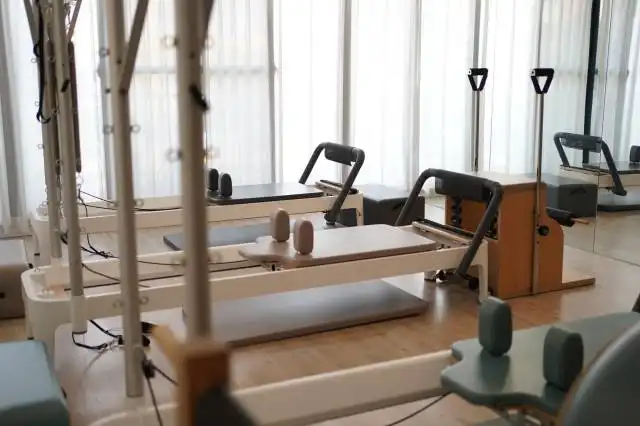Start a Barber Shop
Hair Today, Gone Tomorrow: Crafting Your Community's Sanctuary
| Updated


BARBER SHOP
Are you dreaming about opening a barber shop? Imagine creating a go-to spot where people come not only for a confidence-boosting fresh cut, but also for the engaging atmosphere and deep-rooted sense of community. A barber shop business is all about providing grooming services for men, typically specializing in haircuts, shaves, and trims - but it may also serve as a relaxing sanctuary where conversations are as sharp as the scissors. With your drive and a pair of keen shears, your potential patrons' bad hair days could be sheared away to a thing of the past.
Jump to Business Plan
RELATED BUSINESS IDEAS
Browse ALL Health & Beauty Innovations Business Ideas
Discover Your Perfect Domain
Unlock the door to your online success with our hand-picked selection of premium domain names. Whether you're starting a new venture or rebranding an existing one, the right domain can set the tone for your digital presence. Browse through our curated list, each with its unique potential to enhance your brand's visibility and credibility.
BARBER SHOP MINI BUSINESS PLAN
This a quick reality check to help you identify the strengths and weaknesses of your business concept before you dive in.
Expected Percent Margin:
- Gross Profit Margin: Approximately 50-60%.
- Net Profit Margin: Around 10-15%.
Earnings Expectations:
- Daily Earnings: $200 - $900
- Weekly Earnings: $1,000 - $4,500
- Monthly Earnings: $4,000 - $18,000
- Annual Earnings: $48,000 - $216,000
*Kindly note that these figures may vary. They depend upon various factors, including your shop location, the number of chairs, the price for each service, etc.
Actions to Reach These Numbers:
Service and Pricing:
- Pricing Structure: Average pricing for services ranging from $20-$40 per haircut.
- Variety in Services: Offer an array of services beyond basic cuts (i.e., shaving, grooming, hair treatments).
Staffing:
- Hiring Professional Barbers: Employ skilled full-time or part-time barbers depending on your customer volume.
Customer Base and Marketing:
- Regular Customer Base: Build a loyal customer base where each customer visits at least once a month.
- Community Engagement: Participate in local events, sponsor teams or events if possible.
- Online Presence: Maintain an active presence on social media platforms, such as Instagram.
Financial Management:
- Overhead Costs: Keep overhead costs, such as rent and salaries, to less than 50% of the revenue.
- Retail Products: Selling related products (shampoos, lotions) can increase overall profits by 5-10%.
Operational Hours:
- Open Hours: Open at least 6 days a week, 10-12 hours per day.
Remember, these are rough estimates and can vary widely based on your unique business plan, location, clientele, and other factors. Always consult a business advisor or professional when making financial projections.
NOT WHAT YOU HAD IN MIND? Here are more ideas



Browse ALL Health & Beauty Innovations Business Ideas
Grab Your Business Website Name
Before you get caught up in the whirlwind of setting up your business, invest in a domain name. It's a small but significant step that lays the foundation for your brand and makes it easier for customers to find and trust you. Just like you wouldn't build a house without securing the land first, don't build a business without securing your domain name.
"Why? Can't that wait?" Here's why it shouldn't
Step 1: Determine if the Business is Right for You
Before taking the plunge and starting a barber shop, it is important to determine if the business is right for you. You should consider the startup costs, ongoing expenses, and potential ways to make money. Start by researching the costs associated with opening a barber shop. This includes the cost of the building, equipment, and other necessary supplies. Additionally, there may be licensing and permit fees, as well as taxes, that will need to be taken into account. Once you have a better understanding of the startup costs, you should also consider the ongoing expenses. These include rent, utilities, insurance, and payroll. Additionally, you should factor in the cost of advertising and marketing, as well as any other miscellaneous expenses. Finally, you should consider the potential ways to make money. This includes the cost of haircuts, as well as any additional services you may offer, such as styling, coloring, and waxing. Additionally, you may want to consider selling products such as shampoos, conditioners, and styling products. By taking the time to research the startup and ongoing costs, as well as potential ways to make money, you can make an informed decision as to whether or not starting a barber shop is the right business endeavor for you.
Step 2: Name the Business
Choosing the right name for a business is an important step in the process of starting a barber shop. It is important to choose a name that is memorable and reflects the values of the business. It is also important to make sure the name is not already taken by another business. To choose the right name, brainstorm ideas with friends and family and consider the type of services the barber shop will offer. Additionally, research the names of other barber shops in the area to make sure the name is unique. Once a name has been chosen, it is important to check with the local government to make sure the name is available and to register the business name with the state. Finally, it is important to make sure the name is not trademarked by another business.
Step 3: Secure the Necessary Licenses and Permits
Before starting a barber shop, it is important to research the local and state laws to make sure that the business is compliant with all regulations. Depending on the location, the business may need to obtain a business license, a barber license, and a cosmetology license. Additionally, the business may need to obtain a health permit, a zoning permit, and a fire safety permit. It is important to make sure that the business is compliant with all applicable laws and regulations.
To obtain the necessary licenses and permits, the business owner should contact the local government office. The government office will provide the business owner with the necessary forms and information to obtain the appropriate licenses and permits. The business owner should also contact the local chamber of commerce to make sure that the business is compliant with all local regulations. Additionally, the business owner should contact the state board of cosmetology to make sure that the business is compliant with all state regulations.
Once the business owner has obtained all of the necessary licenses and permits, they should keep them in a safe place. The business owner should also make sure that the licenses and permits are up to date and that they are renewed when necessary. This will ensure that the business is compliant with all applicable laws and regulations.
Step 4: Find a Suitable Location
When considering the size of the shop, it is important to think about the number of barber chairs and other equipment that will be necessary. Additionally, the size of the shop should be large enough to accommodate customers comfortably and provide enough space for the barbers to work. It is also important to consider the size of the shop in relation to the cost of the shop.
The cost of the shop is an important factor when starting a barber shop. It is important to consider the cost of rent, utilities, and any other costs associated with the shop. Additionally, it is important to consider the cost of the equipment needed for the shop, such as barber chairs, mirrors, and other necessary items.
The location of the shop is also an important factor to consider when starting a barber shop. It is important to find a location that is easily accessible to customers and has good visibility. Additionally, it is important to consider the demographics of the area and the competition in the area when selecting a location. It is also important to consider the cost of the shop in relation to the location.
Step 5: Purchase the Necessary Equipment
List of Necessary Equipment
Starting a barber shop requires a lot of equipment. This includes items such as barber chairs, styling chairs, mirrors, shampoo bowls, and a variety of styling tools. Depending on the type of services offered, additional items such as facial steamers, massage chairs, and manicure tables may be necessary. It is important to research the necessary equipment and determine what is best for the barber shop.
Tips on Where to Purchase Equipment
When purchasing the necessary equipment for a barber shop, it is important to shop around and compare prices. Many suppliers offer discounts for bulk orders, so it is important to consider this when making a purchase. Additionally, it is important to purchase quality equipment that will last for many years. It is also recommended to purchase from a reputable supplier with good customer service. Finally, it is important to read reviews and ask for recommendations from other barbers in the area.
Step 6: Hire Employees
Tips on how to find qualified employees
Finding qualified employees for a barber shop is an important step in ensuring the success of the business. Advertising the job opening on job boards and in local newspapers is a great way to start. Additionally, word of mouth is a great way to find qualified employees. Asking current employees, friends, and family if they know of anyone who may be interested in the job is a great way to find qualified employees. Networking with other barbers and stylists in the area is also a great way to find qualified employees.
Tips on how to train employees
Once qualified employees have been found, it is important to provide them with the proper training. Start by providing employees with an overview of the shop’s policies and procedures. This should include information about customer service, safety protocols, and any other relevant information. Additionally, it is important to provide employees with hands-on training. This should include demonstrations on how to use the equipment, how to properly cut hair, and how to interact with customers. It is also important to provide employees with ongoing training to ensure they are up-to-date with the latest trends and techniques. Finally, it is important to provide employees with feedback and support throughout their training. This will help ensure they are comfortable with their job and feel confident in their abilities.
Step 7: Market the Business
Tips on how to market the business
It is important to have a well thought out marketing plan for a barber shop. This should include a combination of traditional and digital marketing strategies. Traditional marketing strategies include things like flyers, radio and television advertisements, and word of mouth. Digital marketing strategies include things like social media, email campaigns, and search engine optimization.
Examples of effective marketing strategies
One example of an effective marketing strategy is to partner with local businesses. This could include offering discounts to customers who come in after visiting a local restaurant, or offering a free haircut to customers who purchase a certain amount of products from a local store. Additionally, offering a loyalty program or referral program can be a great way to attract new customers. Social media can also be a great way to promote the business. Creating a Facebook page, Twitter account, and Instagram account can help to get the word out about the business and attract new customers. Finally, offering discounts or promotions can be a great way to get people in the door and build a loyal customer base.
Step 8: Set Prices
Setting prices for your barber shop services can be a tricky process. It is important to consider the cost of supplies and overhead, as well as the going rate for similar services in the area. You should also consider the value of your services and the experience you provide. It is important to set prices that are competitive and attractive to customers, while still allowing you to make a profit. When setting prices, it is important to consider the cost of supplies and overhead, as well as the going rate for similar services in the area. You should also take into account the value of your services and the experience you provide. Additionally, you should factor in any discounts or promotions you may offer, such as discounts for students or seniors. It is also important to consider the cost of labor and the time it takes to complete each service. You should also research the prices of other barber shops in the area to ensure that your prices are competitive. Finally, you should consider the cost of advertising and marketing to ensure that your prices are attractive to customers.
Step 9: Maintain the Business
Tips on how to maintain the business
It is important to maintain the barber shop in order to keep customers coming back. This includes keeping the shop clean and organized, providing quality customer service, and staying up to date with the latest trends and styles. Additionally, it is important to keep up with the competition and to make sure that the shop is offering services that are competitively priced.
Examples of ways to keep customers coming back
One way to keep customers coming back is to offer loyalty programs, such as discounts for frequent customers or rewards for referrals. Additionally, offering special promotions or discounts on certain services can be a great way to attract new customers. Additionally, offering special events such as free haircuts or discounts for special occasions can be a great way to keep customers coming back. Finally, offering customer feedback surveys and listening to customer feedback can help to ensure that the barber shop is meeting the needs of its customers.
EXPLORE MORE CATEGORIES
Browse ALL Business Idea Categories
TAKE THE NEXT STEPS










